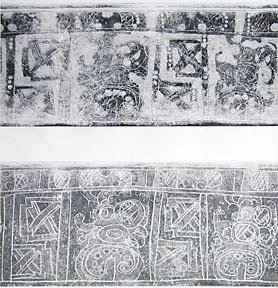For desktop publishing if you need to make multiple copies of photographs, an old-fashioned copy machine is the worst choice (you know the streaks, fuzzy detail...). Nowadays certain laser printers have the capability to reproduce photographs at close to photo-exhibit quality. GCC Technologies is one company that produce such graphics-capable laser printers. Xante and NewGen also produce printers for desktop publishing. NewGen was bought by Itek and we have not heard much of their black-and-white laser printers since then. Xante seems not to wish to have their printers compared point by point with other printers: QMS and GCC both sent printers for evaluation but not a peep from Xante. Since Xante printers cost almost twice as much as GCC (yet use basically the same print engine inside), we feel GCC is the "best buy" for a black-and-white 11x17 inch monochrome laser printer.
GCC Technologies makes printers that are ideal for museums, for curators, for archaeologists (as well as botanists, geologists, art historians, architects...anyone working with photos, pictures, or images).
Just look at the image presented below. This is a rollout of a 7th century Maya vase from Guatemala. The incised line is faint; what little detail that is present has been filled in by the sloppy dark overlay (this vessel may use a form of resist or possibly negative painting; the technique on this series of vases has never been studied by archaeologists).
By careful use of digital imaging software it has been possible to "rescue" the image by "software radar," that is, looking under one layer of paint to see the other layers. No, this is not infrared (that is also possible, indeed the Better Light rollout camera works with infrared directly; all you need to do is remove the infrared shield filter and you get a direct infrared image).
No, the bottom photograph is "digital radar," a process used here at the Digital Imaging Technology Center (a division of the FLAAR Photo Archive). Printer is the GCC Elite XL, 800 dpi (1200 dpi is recommended). GCC printers are available at any outlet that provides professional equipment to the graphics industry.
We liked the 800 dpi model of the GCC laser printer so much that when it was time to get another printer we asked for the 1200 dpi model.
 |
Be sure to avoid desktop laser printers that can only do correspondence; beware of fancy advertising that claims ability to handle graphics... The only printers which do a really good job with graphics are QMS, GCC, Xante, and probably NewGen (Itec). We review QMS laser printers on several other web sites.
If you are interested in learning how to improve your own photographs, then invest some time in perusing the other sites of the FLAAR network...seven other web sites devoted to improving photographic recording through digital technology, both hardware and software. Links are available at the bottoms of most pages; an index (site map or "links to links") are also available on most of the sites within this network of associated sites. The mutual goal is to assist in improving quality in photographic recording and publication, both in desktop publishing or professional prepress.
If you need help in deciding what professional black-and-white laser printer to select, send an e-mail to Nicholas Hellmuth at ReaderService@FLAAR.org. Specify what kind of originals you have, what kind of shop or business (or hobby) you need this printer for, what state or country you are located in, and we will do our best to provide informative assistance. No, we do not sell printers (our institute is non-profit) but we know plenty of people in the laser printer business and can give you tips how to get precisely what you need.
|
Related links
|
|
|
Additional reviews of laser printers, directory-index of www.laser-printer-reviews.org
|
Directory of links to other Maya vase rollouts
|
|
Gateway to Maya vase rollouts in Maya-archaeology
|
Gateway to Maya vase rollouts on another web site, www.digital-photography.org
|































